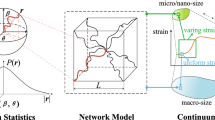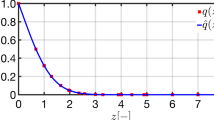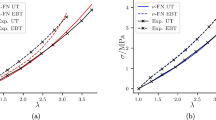Abstract
The purpose of this paper is to present a general upscaling strategy for deriving macroscopic constitutive laws for rubber-like materials from the knowledge of the network distribution and a mechanical description of the individual chains and of their free energy. The microscopic configuration is described by the position of the cross-links and is not obtained by an affine assumption but by minimizing the corresponding free energy on stochastic large representative volume elements with adequate boundary conditions. This general framework is then approximated by using a microsphere (directional) description of the network. It is presented in a global setting and is extended in order to handle situations with tube-like constraints and stress-induced crystallization.











Similar content being viewed by others
References
Beurrot, S.: Cristallisation sous contrainte du caoutchouc naturel en fatigue et sous sollicitation multiaxiale. Thèse de doctorat de l’Ecole Centrale de Nantes (2012)
Behnke, R., Berger, T., Kaliske, M.: Numerical modeling of time- and temperature-dependent strain-induced crystallization in rubber. Int. J. Solids Struct. 141–142, 15–34 (2018)
Candau, N.: Compréhension des mécanismes de crystalisation sous tension des élastomères en conditions quasi-statiques et dynamiques. Ph.D. Thesis, INSA Lyon (2014)
Cohen, A.: A Padé approximant to the inverse Langevin function. Rheol. Acta 30, 270–273 (1991)
Diani, J., Le Tallec, P.P.: A fully equilibrated microsphere model with damage for rubberlike materials. J. Mech. Phys. Solids 124, 702–713 (2019)
Göktepe, S., Miehe, C.: A micro-macro approach to rubber-like materials. Part III: the micro-sphere model of anisotropic Mullins-type damage. J. Mech. Phys. Solids 53, 2259–2283 (2005)
Gloria, A., Le Tallec, P., Vidrascu, M.: Foundation, analysis, and numerical investigation of a variational network-based model for rubber. Continuum Mech. Thermodyn. 2013, 1–31 (2013)
Govindjee, S., Zoller, M.J., Hackl, K.: A fully relaxed variationnally-consistent framework of inelastic micro-sphere models: finite viscoelasticity. J. Mech. Phys. Solids 127, 1–19 (2019)
Guilie, J., Lê, T.N., Le Tallec, P.: Microsphere model for strain-induced crystallization and three dimensional applications. J. Mech. Phys. Solids 81, 58–74 (2015)
James, A.G., Green, A., Simposon, G.M.: Strain energy functions of rubber. I characterization of gum vulcanizates. J. Appl. Polym. Sci. 19, 2033–2058 (1975)
Kawabata, S., Matsuda, M., Tei, K., Kawai, H.: Experimental survey of the strain energy density function of isoprene rubber vulcanizate. Macromolecules 14, 154–162 (1981)
Khiêm, V.N., Itskov, M.: Analytical network-averaging of the tube model: strain-induced crystallization in natural rubber. J. Mech. Phys. Solids 116, 350–369 (2018)
Loos, K., Aydogdu, A.B., Lion, A., Johlitz, M., Calipel, J.: Strain-induced crystallization in natural rubber: a thermodynamically consistent model of the material behaviour using a multiphase approach. Continuum Mech. Thermodyn. 32, 501–526 (2020)
Merckel, Y., Diani, J., Brieu, M., Caillard, J.: A Mullins softening criterion for general loading conditions. J. Mech. Phys. Solids 60, 1257–1264 (2012)
Miehe, C., Göktepe, S., Lulei, F.: A micro-macro approach to rubber-like materials. Part I: the non-affine micro-sphere model of rubber elasticity. J. Mech. Phys. Solids 52, 2617–2660 (2005)
Rastak, R., Linder, C.: A non-affine micro-macro approach to strain-crystallizing rubber-like materials. J. Mech. Phys. Solids 111, 67–99 (2018)
Ruelle, D.: Statistical Mechanics. Rigorous Results. World Scientific Publishing Co., Inc., River Edge; Imperial College Press, London (1999). Reprint of the 1989 edition
Tkachuk, M., Linder, C.: The maximal advance path constraint for the homogenization of materials with random network microstructure. Phil. Mag. 92, 2779–2808 (2012)
Treloar, L.R.G.: Stress–strain data for vulcanized rubber under various types of deformation. Trans. Faraday Soc. 40, 59–70 (1944)
Verron, E., Gros, A.: An equal force theory for network models of soft materials with arbitrary molecular weight distribution. J. Mech. Phys. Solids 106, 176–190 (2017)
Acknowledgements
The authors would like to thank Klara Loos, Alexandre Lion and Jérôme Calipel for providing useful data and discussion.
Author information
Authors and Affiliations
Corresponding author
Additional information
Communicated by Andreas Öchsner.
Publisher's Note
Springer Nature remains neutral with regard to jurisdictional claims in published maps and institutional affiliations.
Appendix: Time discretization and Newton algorithm
Appendix: Time discretization and Newton algorithm
Let us introduce the chain traction \(f_R\) as imposed by equilibration together with the constitutive expression \( \displaystyle f(\lambda , \lambda _{\chi })= \frac{1}{Nb} \frac{\partial \psi _R}{\partial \lambda }\) for the chain traction and \( \displaystyle f_\chi (\lambda , \lambda _{\chi })= - \frac{\partial \psi _R}{\partial \lambda _\chi }\) of the crystallization thermodynamic force. Moreover, the notations \(\lambda _0(\lambda _{\chi })\) and \(\lambda _Y(\lambda _\chi )\) denote the solutions of \(f_\chi (\lambda _0(\lambda _\chi ),\lambda _\chi )=0\) and of \(f_\chi (\lambda _0(\lambda _\chi ),\lambda _\chi )=Y(\lambda _\chi )\), respectively.
After time implicit discretization, the flow rule (41) writes
-
1.
if \(f_R< f(\lambda _E,0)\), there are no crystallites, \( \lambda _{\chi }^{n+1} = 0 \) and \(\lambda \) is obtained by solving \(f(\lambda ,0)=f_R\);
-
2.
if \(f(\lambda _E,0)< f_R \le f(\lambda _0(\lambda _{\chi }^n), \lambda _{\chi }^n)\), we are in a fusion phase, \( \lambda \) and \(\lambda _{\chi }^{n+1}\) being obtained by solving
$$\begin{aligned}&f_\chi (\lambda , \lambda _{\chi }^{n+1}) =0,\\&f(\lambda , \lambda _{\chi }^{n+1})=f_R; \end{aligned}$$ -
3.
if \(f(\lambda _0( \lambda _{\chi }^n), \lambda _{\chi }^n)< f_R \le f(\lambda _Y( \lambda _{\chi }^n), \lambda _{\chi }^n)\), we are in a freezing situation, \( \lambda _{\chi }^{n+1} =\lambda _{\chi }^{n}\), \(\lambda \) being obtained by solving \(f(\lambda ,\lambda _{\chi }^{n+1})=f_R\);
-
4.
if \( f(\lambda _Y( \lambda _{\chi }^n), \lambda _{\chi }^n)< f_R \le f(\lambda _0( \lambda _{\chi ,sat}), \lambda _{\chi ,sat})\), we are in a crystallization phase, \( \lambda \) and \(\lambda _{\chi }^{n+1}\) being obtained by solving
$$\begin{aligned}&f_\chi (\lambda , \lambda _{\chi }^{n+1}) =Y ( \lambda _{\chi }^{n+1}),\\&f(\lambda , \lambda _{\chi }^{n+1})=f_R; \end{aligned}$$ -
5.
if \( f(\lambda _0( \lambda _{\chi ,sat}), \lambda _{\chi ,sat}) < f_R\), we are at saturation, \(\lambda _{\chi }^{n+1}=\lambda _{\chi ,sat}\) and \(\lambda \) is obtained by solving \(f(\lambda ,\lambda _{\chi ,sat})=0\).
All above nonlinear systems reduce to a nonlinear scalar equation with respect to the unknown \(f_a=\frac{\partial {\psi _\beta }}{\partial \lambda }(\lambda _a)\) with \(\lambda _a=(\lambda -\lambda _\chi )/(1-\lambda _\chi )\). They explicitly define the total elongation \(\lambda \) and the new crystallization ratio \(\lambda _\chi \) of a given chain together with their derivatives in function of the chain traction \(f_R\).
Applying the Newton algorithm to the nonlinear stress Eq. (28) leads then to the following algorithm where we have omitted the superscript \({n+1} \) for simplicity:
For a given stress tensor \(\underline{\underline{S}}_{\mathrm{c}}\), and while the residual is not sufficiently small
-
1.
Compute the orientation vector \(\displaystyle \underline{f}= \underline{\underline{S}}_{\mathrm{c}}\cdot \underline{\underline{l}}_0^{-t} \cdot \underline{R}\) for every orientation \(\underline{R}\);
-
2.
Compute its norm after transport \(f_R=| \underline{f}|_{\mathrm{C}} = \sqrt{\underline{f} \cdot \underline{\underline{C}} \cdot \underline{f}}\) and its derivative with respect to \(\underline{\underline{S}}_{\mathrm{c}}\) defined by
$$\begin{aligned} \underline{\underline{U}}_R : \underline{\underline{\mathrm{d}S}} = \frac{\partial f}{\partial \underline{\underline{S}}_{\mathrm{c}}} : \underline{\underline{\mathrm{d}S}} = \frac{1}{2 f_R}( \underline{\mathrm{d}f} \cdot \underline{\underline{C}} \cdot \underline{f} + \underline{f} \cdot \underline{\underline{C}} \cdot \underline{\mathrm{d}f}) \end{aligned}$$with \(\displaystyle \underline{\mathrm{d}f} = \underline{\underline{\mathrm{d}S}} \cdot \underline{R}= \underline{R}\cdot \underline{\underline{\mathrm{d}S}}^t\).
-
3.
For all N, compute the chain extension \(\lambda _{R,N}(f_R)\) and its derivative \(\frac{\mathrm{d} \lambda _{R,N} }{d f_R}\) as indicated in the above resolution of the time discretized flow rule.
-
4.
Compute by directional integration
$$\begin{aligned} \underline{\underline{S}}_{inv} = \underline{\underline{l}}_0^{-t} \cdot \int _{S^{2} \times N} Nb \frac{\lambda _{R,N}}{f_R} \underline{R}\otimes \underline{R}P(N, \underline{R}) \mathrm{d}N |\mathrm{d}\underline{R}| \, \cdot \underline{\underline{l}}_0^{-1}, \end{aligned}$$the equilibration residual
$$\begin{aligned} \underline{\underline{\text{ Res }}} = \underline{\underline{S}}_{\mathrm{c}}\cdot \underline{\underline{S}}_{inv} - \frac{1}{9} \underline{\underline{\text {Id}}}, \end{aligned}$$and its derivative with respect to \(\underline{\underline{S}}_{\mathrm{c}}\)
$$\begin{aligned}&\underline{\underline{\underline{\underline{M}}}}: \underline{\underline{\mathrm{d}S}} := \frac{\partial \underline{\underline{S}}_{inv}}{\partial \underline{\underline{S}}_{\mathrm{c}}}: \underline{\underline{\mathrm{d}S}}\\&\quad = \underline{\underline{l}}_0^{-t} \cdot \int _{S^{2} \times N} Nb \left( \frac{1}{f_R} \frac{\mathrm{d} \lambda _{R,N} }{\mathrm{d} f_R}- \frac{\lambda _{R,N}}{f_R^2}\right) \underline{R}\otimes \underline{R}\, \underline{\underline{U}}_R: \mathrm{d} \underline{\underline{S}} P(N, \underline{R}) \mathrm{d}N |\mathrm{d}\underline{R}| \cdot \underline{\underline{l}}_0^{-1}, \\&\frac{\mathrm{d} \underline{\underline{\text{ Res }}}}{\mathrm{d} \underline{\underline{S}}_{\mathrm{c}}}: \underline{\underline{\mathrm{d}S}}= \underline{\underline{\mathrm{d}S}}:\underline{\underline{S}}_{inv} + \underline{\underline{S}}_{\mathrm{c}}\cdot \underline{\underline{\underline{\underline{M}}}} : \underline{\underline{\mathrm{d}S}}. \end{aligned}$$ -
5.
Solve the linear system
$$\begin{aligned} \frac{\mathrm{d} \underline{\underline{\text{ Res }}}}{\mathrm{d} \underline{\underline{S}}_{\mathrm{c}}} : \mathrm{d}\underline{\underline{S}}_{\mathrm{c}}= - \underline{\underline{\text{ Res }}}, \end{aligned}$$set \(\underline{\underline{S}}_{\mathrm{c}}= \underline{\underline{S}}_{\mathrm{c}}+\mathrm{d}\underline{\underline{S}}_{\mathrm{c}}\) and go back to step 1 of algorithm.
Rights and permissions
About this article
Cite this article
Le Tallec, P., Diani, J. Variational upscaling for modeling state of strain-dependent behavior and stress-induced crystallization in rubber-like materials. Continuum Mech. Thermodyn. 33, 749–766 (2021). https://doi.org/10.1007/s00161-020-00954-5
Received:
Accepted:
Published:
Issue Date:
DOI: https://doi.org/10.1007/s00161-020-00954-5




